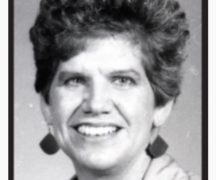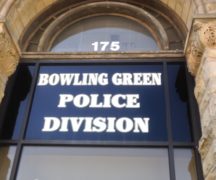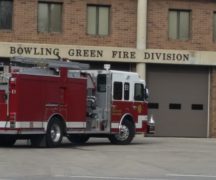By JAN LARSON McLAUGHLIN
BG Independent News
When Bowling Green Mayor Mike Aspacher watched the video of George Floyd’s death, he had some questions for his city’s police division.
What’s the policy on chokeholds? Are officers required to intervene when a fellow officer is using excessive force? And does BGPD follow the “8 Can’t Wait” police reform policies that reportedly can decrease police violence by 72%?
As the nation erupted with anger and anguish, Aspacher wanted answers.
“It all goes back to the murder of George Floyd. I’m not reluctant to call it what it was,” he said. “I was absolutely outraged and heartbroken.”
Bowling Green Police Major Justin White understands the anger.
“I completely understand it. I agree with it,” White said.
But he also wants the community to realize that BGPD doesn’t work that way. The police division doesn’t allow chokeholds unless it’s a life or death situation. Officers are required to intervene if a fellow cop is using unnecessary force.
Knees on the neck of a suspect are not allowed.
“There is no reason for that,” White said.
The division already follows the “8 Can’t Wait” policies, it adheres to Ohio Collaborative Community Police standards, and it is certified by the Commission on Accreditation for Law Enforcement Agencies (CALEA.)
And as part of the annual reaccreditation process, the police division has to make public its statistics on issues such as use of force and bias-based policing.
That was a relief to Aspacher, who took over as mayor in January.
“We want to be transparent about all our policing policies,” he said. “It reinforced what I already expected. They are so professional and dedicated to those principles.”
White acknowledged there are weaknesses that the police division needs to work on. Officers have dash cams in their vehicles, but do not have body cameras.
The division has been working toward getting body cameras, but the cost has been prohibitive. Preliminary estimates put the cost of the cameras at $100,000 to $120,000, with another $25,000 or so annually for storage of the footage.
“That’s something we’ve been planning for,” said White, who is also seeking grant funding for the body cameras.
The other glaring deficiency is the lack of any black officers on the police force.
“Absolutely, minority representation has been a weakness of ours,” White said.
The police division has tried to remedy that issue by recruiting in more urban areas, and is looking into using a national testing network.
“Bottom line, we’re not just sitting and saying, ‘That’s the way it is.’ We’re trying” to hire officers of color, White said.
As for officer conduct, White said BGPD sets high standards, keeps detailed records, and is transparent with the public.
As for the specific issue of chokeholds, White said the police division has never endorsed that as a tactic in his 20 years on the force.
“We don’t train on that, we never have,” he said.
And the division’s code of conduct requires officers to do more than stand by when excessive force is being used.
“We train our officers that they have a duty to intervene,” White said. The code of conduct goes a step further by requiring officers to report any excessive use of force.
Anytime force is used – whether it’s a Taser, baton, pepper spray, or firearm – it must be reported. Any weaponless force, such as when an officer displaces a person’s balance through pushing or using pressure holds, must also be reported.
BGPD officers used force 21 times last year, White said. In the vast majority of cases, the police did not use weapons. The last officer involved shooting in Bowling Green was in 2011.
Officers must file use of force reports if they observe an injury occur, or if a person complains of an injury. “They won’t go home till it’s done,” White said of the reporting requirement.
Officers go through frequent training on how to de-escalate situations, and use the least amount of force needed.
Last September, cell phone video surfaced on social media of an incident on East Court Street just as bars were closing downtown. The video showed a man shoving a police officer, then a crowd circling and shouting. Several officers responded – but not one pulled a firearm, Taser or pepper spray. One officer used a baton, but only to push back spectators from the scene.
“Training creates discipline,” White said of the skills that allow officers to not escalate situations. “Mental discipline is a crucial component.”
Though police train with firearms, Tasers, pepper spray and batons, they are taught to use their minds and words first whenever possible.
“Our guys have learned their best weapon is their mouth. Use your head to de-escalate,” White said.
Complaints made to BGPD about excessive force are not ignored, White said.
“People have lots of avenues to report complaints,” he said. “We’ll take complaints anonymously.”
Complaints go through several levels of investigation, including the officer’s sergeant, internal affairs, Chief Tony Hetrick, Municipal Administrator Lori Tretter, and the mayor.
Eight complaints were filed last year. Details on all those complaints are not yet available, since CALEA is behind on its annual reports due to the coronavirus pandemic.
Officers’ records are reviewed quarterly to look for any bias in policing tactics. The police division conducts trainings to make sure profiling isn’t used in areas such as traffic stops, search issues, asset seizure and forfeiture, and interview techniques. Annual training is required in cultural diversity, discrimination and community support.
The BGPD also tracks any early warning signs of employee problems such as abnormal use of sick time, plus internal and external complaints.
“This allows us to get the overall picture of the employee’s behavior,” White said.
The police division has progressive discipline policies, which start with steps like reprimands in personnel files or referrals to counseling. Detailed documentation is kept – so the police division can get rid of “bad apples.”
“That’s why you should have policies and procedures in place that are followed,” White said. “We can’t drag our feet.”
Since 1993, BGPD has been accredited by CALEA – which is considered the “gold standard” of law enforcement credentialing, and has 484 standards that must be met annually. About half of police departments have that accreditation.
BGPD also meets the requirements of the Ohio Collaborative Community Policing standards. More than 400 Ohio police agencies do not meet that certification.
CALEA requires that stats be kept on possible profiling with traffic stops.
“We monitor that. We keep an eye on that,” White said. “There is no indication that we stop someone by their race disproportionately.”
The population served by Bowling Green Police Division is approximately 88% white, 6% black and 6% Hispanic. However, the census numbers don’t reflect the transient population at BGSU, where many students don’t complete the census forms. Being a college town, the city also sees a lot of out-of-town visitors to downtown bars, sporting and cultural events, White pointed out.
Following is a list of 1,278 arrests made in 2018, divided by race and gender:
- White males, 692 (54.2%)
- White females, 310 (24.3%)
- Black males, 184 (14.4%)
- Black females, 75 (5.87%)
- Hispanic males, 12
- Hispanic females, 3
- Other females, 2
Following is a breakdown on the use of force frequency by BGPD officers in 2018, plus the race of the people the force was used on:
- Firearm discharge – None.
- Taser use: 3 white males, 1 black male.
- Baton use: 1 white male.
- Pepper spray use: 1 black male, 1 Hispanic male, 1 other female.
- Weaponless: 16 white males, 6 white females, 9 black males.
There were no use of force complaints filed in 2018.
In 2018, a total 7,566 traffic warnings and citations were recorded as follows:
- White males, 3,392
- Black males, 572
- Hispanic males, 92
- Other males, 48
- White females, 2,973
- Black females, 420
- Hispanic females, 47
- Other females, 21
Traffic warnings given to males can be divided into: 84% to whites, 13% to blacks, 2% to Latinos, and 1% to other.
Traffic citations given to males were: 80.5% to whites, 15.5% to blacks, 3% to Latinos, and 1% to other.
Traffic warnings given to females were: 86% to whites, 12% to blacks, 1% to Latinos, and 1% to other.
Traffic citations given to females: 85% to whites, 13% to blacks, 2% to Latinos.
No complaints were filed in 2018 about biased based profiling. One complaint was filed in 2017, and an internal affairs investigation was initiated. Two officers were disciplined, but the findings showed there was no bias. The incident involved a violent felon reportedly resisting arrest. One supervisor was disciplined for failing to take control of the situation, and an officer was disciplined for conduct unbecoming after swearing at the person arrested.
Following are some preliminary statistics from 2019:
- 19 use of force reports were filed by BGPD officers. That is a decrease from 38 in 2018.
- 16 different officers filed the reports. The highest numbers of reports were filed by three patrolmen, all who work the midnight shift and encounter more people who are under the influence or disorderly. Examination of those officers revealed no patterns, and all usage was deemed appropriate.
- The most common “use of force” involved no weapons.
- Incidents requiring force included disorderly conduct/fighting, resisting arrest, fighting/assault, menacing, trespassing, mentally ill, and alcohol/under the influence.
- Breakdowns by race and gender are as follows: white males, 6; white females, 3; black males, 5; black females, 0; Hispanic males and females, 0.
Two use of force complaints were addressed in report:
- One involved a white female in her 60s, who reported excessively rough treatment when she was handcuffed and taken into custody for obstructing. She reported the complaint weeks after the incident. Video evidence reportedly showed no force being used that would have caused injury, and witnesses to the arrest reportedly stated the same.
- The second complaint was from a black male who said an officer threatened to use a Taser on him as he fled during a foot pursuit. The man was arrested, no Taser was deployed, and the officer denied that he said a Taser was going to be used.
Following are the “8 Can’t Wait” policies used by BGPD that reportedly can decrease police violence by 72%:
Chokeholds/Strangleholds – The BG Police Division does not authorize the use of neck restraints except in defense of human life. Bottom line, an officer would only use this as a technique of opportunity in a deadly force situation, White said.
Require De-escalation – Crisis Intervention Training (CIT) and de-escalation has been an on-going division training priority since 2003. The police division works closely with Wood County ADAMHS Board, NAMI, and local mental health providers. CIT and de-escalation is more than just a concept, it is ingrained in the culture of the division, White said. Officers utilize these techniques on a regular basis, which has resulted in a reduction of officers using force.
Require Warning before Shooting – Policy does not require a warning prior to shooting; however, officers are instructed to provide a warning, if feasible.
Exhaust All Means before Shooting – The division’s policies and training covers various options to de-escalate a situation, if possible, and to only use the amount of force necessary to control and/or neutralize the situation.
Duty to Intervene – Officers are required to intervene if unnecessary force is used, and report such incidents.
Ban Shooting from Moving Vehicles – The division does not allow shooting from vehicles.
Require Use of Force Continuum – Several of the division’s use of force policies address Action-Response Use of Force Continuum, which is covered extensively in trainings.
Require Comprehensive Reporting – All officers must complete a Response to Resistance/Aggression (RRA) report as soon as practical following the incident. Officers will complete reports in all instances of injury, observation of injury, complaint of excessive force, and/or force used above the level of balance displacement.
In addition to these eight recommendations, the police division also has a policy addressing the need for officers to render appropriate aid to the subject.
White acknowledged that BGPD can always do better. Adhering to training and reporting requirements, and well as improving community relationships are a constant focus, he said.
“If you’re stagnant, you’re moving backward, you’re not moving forward,” he said.





